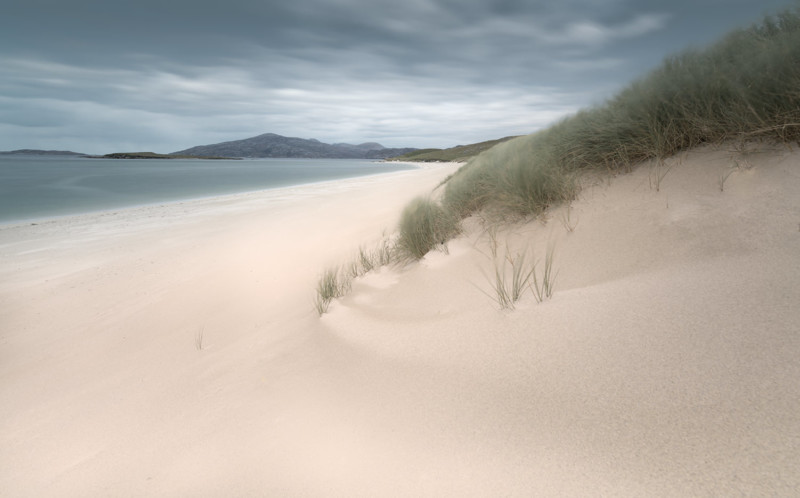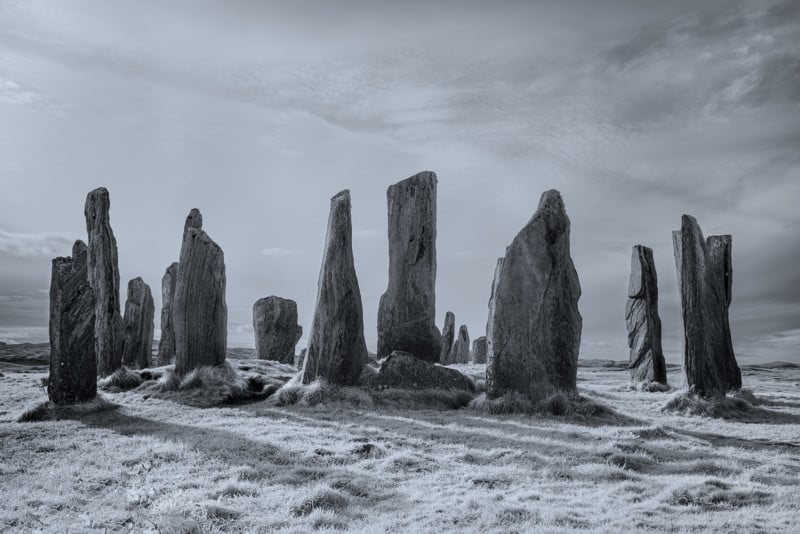

Torridon, Glencoe, and the Isle of Skye have drawn landscape photographers and artists over the centuries. The highlands of Scotland are extensive and uninterruptedly breathtaking – a Big Country indeed. This is the internationally perceived face of Scotland – a meticulously sculpted land of peaks, glens, lakes, and shorelines. And rain or mist to make or break the scene dependent on your disposition.
But distant from the western shore, an extensive string of pearls awaits the more intrepid traveler. The Outer Hebrides stretch for 140 miles – a sliver of land 40 miles away resting on the horizon. They are comprised of the joint isles of Harris and Lewis, North Uist, Benbecula, South Uist, and Barra.
Here is a different Scottish landscape. Pure and wild, beaches to melt a heart, rolling hills and lakes, abandoned homesteads left furnished some 70 years ago – a unique landscape tied to culture. Time slows down out here. The clock ticks to a different beat. There is a softness to the landscape that sways with this rhythm.
Tarbert is a port town, a docking place for the ferry from Skye but a taste of other times hangs in the air. Terraced cottages line the side of the hill. We rented a cottage for four nights and set off to dip our toes into the landscapes of Harris and Lewis. Not an hour and a half after stepping off the ferry we walked the length of Seilebost beach.
A little travel weary – but the landscape just soaked us up and soothed us in. I took some initial photographs on the beach into blue hour – just to let the camera out of the bag as the light was dull and dimming. We drove back to Tarbert in the dark. We had indeed arrived.
At dawn the following morning we sat in the sandy car park at Rosamol as the skies provided a free car wash. There were two other cars and a camper van – each seemingly daring the other to take to the beach first. The rain eased and we walked the wet sandy track to the wide beach. The hills of Harris dipped in and out of clouds. The light was a dirty grey and the photographs taken that morning were a reflection of the weather. But the hills and islands encroaching the beach were akin to an amphitheater and made an instant impression that would draw us back to this beach.
The eastern shore of Harris is pockmarked with tiny lochs that meet the sound of the Minch, the strait that divides the isles from the highlands. The western shore could not be more different – the lauded beaches that deservedly act as a magnet for landscape photographers and artists. The beaches lend themselves to the creation of dreamlike impressions that longer exposures serve best. I fully expected my wide-angled lens would live on my camera body for the trip but found that longer focal lengths better served my purposes.
All of the beaches along the western shore deserve a dedicated visit. Horgabost beach is compact and suffers from occasional drifts of dead seaweed as was the case when an unexpected burst of evening light necessitated an impromptu visit. The beach was not an option so I hurriedly ran atop the dunes and shot to exclude it – a 6-second exposure to soften the marram grass as it merged with the Atlantic.
 Horgabost beach
Horgabost beach
The following day we took the spectacular single-track road to Huisinis beach and witnessed golden eagles and a large migration of redwings on the route.
 Huisinis beach
Huisinis beach
This is another compact beach good enough to shoot independently but the jewel of the area is Tragh Mheallan. The beach requires a good 45-minute walk with an incline along a well-marked cliff path.

An otter greeted me along the cliff walk. A white-tailed eagle flew overhead. The beach was enormous and empty. The marram grass held no human footprint but was indented by the tracks of deer. My composition was rushed as the light faded on an overcast afternoon. An enthralling location.
Luskentyre is the most popular beach in Harris – it is effectively a bay – Rosamol and Seilebost beaches at either side. I visited for two sunrises during our stay once on each side.
 Luskentyre beach
Luskentyre beach
Rosamol should be your first choice as it was mine. The light on my dawn visit was dull. The dunes and distant mountains though impressive deserved better light. A beach tends to fare better in duller light and so my preferred images were abstract in nature and the compositions drew substantially on the sands. At Seilebost, the light was a slight improvement and I played with a layered composition of rocks, sea, sand, mountains, and sky.
And so we had spent 3 days exploring parts of Harris and had not yet ventured into Lewis – the largest part of the island. A trip to this island would not be complete without a visit to Callanais Standing Stones and that is where our final day took us. Out of the bag came the infrared camera for a noon shot of this archaeological wonder.
 Callanais Standing Stones
Callanais Standing Stones
The afternoon was drawing in but we pressed on further from home to the Mangarsta Sea Stacks.
 The Mangarsta Sea Stacks
The Mangarsta Sea Stacks
The light was never going to be interesting but to view the scene and take an image for the sake of it was worth the effort. And so our short sojourn to the Outer Hebrides ended.
Here are two videos of my 2021 trip to Scotland showing my landscape photography outings in a vlog style:
About the author : Jimmy Mc Donnell is a landscape and wildlife photographer from Co Wicklow, Ireland with an enduring passion for capturing images that reflect the beauty of the natural world. The opinions expressed in this article are solely those of the author. You can find more of Mc Donnell's work on his website and YouTube. This article was also published here.






#inspiration #spotlight #travel #walkthroughs #jimmymcdonnell #landscape #landscapephotography #outerhebrides #scotland #travelphotography





